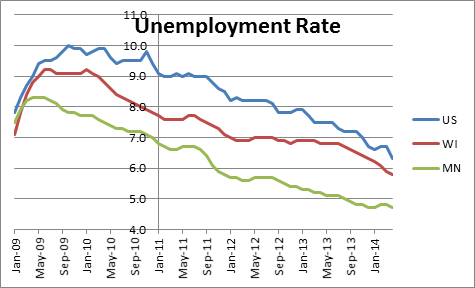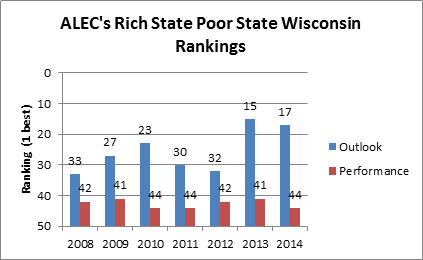Walker’s Record on Unemployment
Wisconsin has had less success reducing unemployment than surrounding states. Why?
By now, it is clear Wisconsin will fall far short of the 250,000 new private sector jobs promised by Governor Scott Walker during his campaign for the governorship. As of April, the increase is around 113,000. If Wisconsin’s private sector jobs increase at the average rate of the past twelve months the state will fall about 100,000 short of the goal.
An argument can be made that the promise was never realistic–that a better measure of success would be to compare Wisconsin with the average state, particularly neighboring states. But here, too, Wisconsin falls short. As can be seen in the first graph, Wisconsin’s job growth of 4 percent falls well below the U.S. increase of about 7 percent and below all but one neighboring state — Illinois. That state’s economic difficulties are generally blamed on its public pension problems; Wisconsin, by contrast, is considered one of the best funded pension systems.
Given the weak numbers for job creation, the governor and defenders of his policies often turn to the unemployment rate, pointing out that Wisconsin is below the national average in this category. But, Wisconsin’s rate was well below the national average when Walker entered office. Since then, the gap between Wisconsin’s rate and the nation’s has actually narrowed. When Walker took office, Wisconsin’s unemployment rate was 1.4 points below the nation’s; but the gap has gradually narrowed since then to just 0.5 points.
There has been remarkably little discussion either by the governor or by advocates of his policies of Wisconsin’s disappointing jobs performance or possible reasons behind it. Instead they continue to claim Walker’s policies are a great success. Lacking a discussion from the governor, I turned to the conservative-oriented Wisconsin web sites. There are a large number of such sites, but most seem much more interested in producing debating points than serious research and analysis. Two seemed most promising:
- The most scholarly of the sites is the Wisconsin Policy Research Institute with its Wisconsin Interest journal. But a recently published article by Tom Hefty and John Torinus on the Wisconsin economy did not address the jobs shortfall. Nothing else on the site was relevant to the issue.
- I next turned to the MacIver Institute, which describes itself as “a Wisconsin-based think tank” that “will produce a new generation of ideas to make Wisconsin great again.” This suggests it has intellectual ambitions that go beyond cranking out propaganda. I mainly searched on two tabs, one entitled “It’s Working Wisconsin” and the other “Research,” back to October 24, 2001. Again I found no discussion of Wisconsin job growth.
The other conservative web sites were even less productive. Apparently there is a consensus that the way to deal with bad news is to avoid talking about it, rather than face it and learn from it.
With good news, however, the story was quite different. For example, last April MacIver posted an item headlined “Wisconsin Jumps 17 Spots in Economic Outlook Ranking,” referring to the 2013 edition of a publication called Rich States Poor States, published by the American Legislative Exchange Council (ALEC) and authored by Arthur Laffer. ALEC’s report ranks states using two measures: “Outlook” ranks states according to how well their policies conform to ALEC’s recommendations. “Performance” ranks states by various economic measures. MacIver treats the 2013 report as vindication: “The state currently ranks 41st in economic performance, but improved from 42nd last year, and 44th in 2010 when Walker took office.”
In the 2014 report, the news was not so good. Wisconsin fell backwards on both rankings. So MacIver simply let this update pass without comment. It seems likely that the apparent improvement in the 2013 Performance ranking that stirred MacIver’s enthusiasm was simply statistical noise. Why the improved Outlook rank didn’t lead to improved Performance is another topic unaddressed.
Models explaining how things work are useful things for imposing some order on an often chaotic and complex reality. But it is way too easy for interesting models to turn into rigid ideologies, immune to evidence or testing. Nowhere is this more evident than in the reaction—or rather the lack of reaction–to the poor employment results in Wisconsin.
Data Wonk
-
Life Expectancy in Wisconsin vs. Other States
 Dec 10th, 2025 by Bruce Thompson
Dec 10th, 2025 by Bruce Thompson
-
How Republicans Opened the Door To Redistricting
 Nov 26th, 2025 by Bruce Thompson
Nov 26th, 2025 by Bruce Thompson
-
The Connection Between Life Expectancy, Poverty and Partisanship
 Nov 21st, 2025 by Bruce Thompson
Nov 21st, 2025 by Bruce Thompson























Wisconsin and the USA has been shedding production type jobs that all service jobs depend on for survival for decades, and the losses fueled by tax policies that came out of the 1980s and increased competition worldwide. During the last downturn, Wisconsin lost multiple paper mills, two remaining car manufacturing plants in Kenosha and Janesville and they have not been replaced by anything that resembles equivalent jobs. We can go down the list of companies that have closed up shop or are a ghost image of the former plants: Allis Charmers, Allen Bradley (Rockwell), Caterpillar, Perfex, Nordberg, Louis Allis, Babcock and Wilcox, General Electric, Kearny Trecker, Milwaukee Road, GM, Chrysler, American Motors, and the Menomonee Valley held 50,000 manufacturing jobs at one time, and now about 7,000.
At the end of WWII, the USA held 60% of the planet’s economy as most competition was wiped out. Today, the USA holds 18% of the world’s economy and is in contraction, and China at 18% on the upswing. The USA is 5% of the planet’s population and consumes 40% of the available energy. There are many resource constraints facing the USA today that are rarely discussed by state and national political leaders.
Labor production jobs were plentiful in the past with a family purchasing power reaching a peak in 1968-69 and on the decline since that time period. There is a law of economics that a region has to have a balance of 1/3 production jobs to maintain the other 2/3 of the service jobs in consulting, government, retail, restaurant, healthcare, etc. to remain viable. Coming out of the last economic downturn, I have not seen any public discussion, news print, or the political arena on detailed analysis on potential solutions and an overall vision and strategy. It is as if we just plod along and hope it goes away, leave the mess for the next guy or generation.